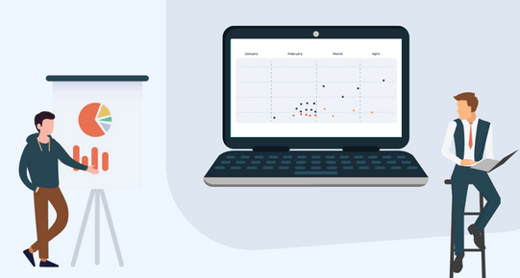Share this
5 Things You Can Learn from an Employee Utilization Report
by Jarno Koopman on January 20, 2023

For professional service businesses, the bulk of revenue is often earned by highly skilled individuals– architects, software developers, designers, consultants, etc– whose productivity can have a major impact on the cash flow of the business.
When your team members are efficient, profitability increases; when they’re inefficient, you may have to deal with scope creep and lost revenue.
The solution? Find out how efficient your employees really are with hard data.
A great way to gain insights into the productivity of employees is by generating an employee utilization report.
This will help you see how employees are spending their time, where there may be room for improvement, and if someone looks like they’re in danger of burnout.
To maximize your team’s billable utilization, run an employee utilization report to see what kind of insights you can gather.
In this article, we’ll explain the employee utilization report, what’s included, and the top 5 nuggets of knowledge that can help you increase the efficiency of your team.
What is an employee utilization report?
An employee utilization report displays billing efficiency based on overall capacity, logged hours, and billable vs non-billable time. This report will demonstrate the workload for an employee during a specific project, client, or period of time.
When you create an employee utilization report, you essentially want to figure out how productive and billable each employee is. The billability of your team can be reflected in a couple of different figures:
- Employee Utilization Rate- The employee utilization rate measures the individual’s work hours against their total capacity. This figure shows how much the employee is putting into work versus how much time they could potentially be putting in.
- Billable Utilization Rate- The billable utilization rate measures the individual’s billable hours against their total capacity. This figure is solely concerned with billable time, as things like internal admin, team-building exercises, etc are not included.

Creating an Employee Utilization Report
To create an employee utilization report, you’ll need a few data points that should be included or somehow connected with your resource management software:
- Total capacity- How much time did the employee have available?
- Total hours- How much time did the employee log?
- Total billable hours- How much time was able to be billed out?
With these three data points available, you can easily create an employee utilization report across a team or even organization-wide.
To make an employee utilization report, you have a couple of options:
- Create a spreadsheet with Excel or Sheets. Include a column for the employee name, total hours, total capacity, total billable hours, employee utilization rate, and billable utilization rate. Here are the formulas to plug in:
Employee Utilization Rate = Total work hours/Capacity x 100%
Billable Utilization Rate = Total billable hours/Capacity x 100%
- You can seamlessly create an employee utilization report using PSA software. PSA software connects with your project data, your time tracking, and your resource management. Simply plug in the parameters to generate an employee utilization report within seconds.
To boot, a PSA tool keeps project managers constantly in the loop with real-time dashboards that display monthly utilization like this:
PSOhub: PSA Software with Built-In Resource Management
5 Important Things You Can Learn from Your Employee Utilization Report
The employee utilization report is a useful document for comprehensive resource management. It can help you more accurately plan your resources and maximize billable utilization, aka the percentage of billable hours by each employee. Here are the 5 most impactful pieces of information that the employee utilization report can give you:
1. Productivity insights
One of the best things about the employee utilization report is that you can find out how billable the person is. How much of your employee’s time is spent on billable work? While the employee utilization rate shows work hours compared to capacity, it doesn’t reflect billable versus non-billable time. Check the billable utilization column on the employee utilization report that will tell you how billable the person is.
2. Signs of burnout
The opposite of a glaring productivity lapse is a sign of burnout. If you see someone consistently at or over capacity– aka near 100% or over– on their employee utilization rate month in and month out, burnout may be just around the corner. For the employees whose utilization seems too good to be true, check in with them. Use capacity planning throughout the lifecycle of your projects to catch signs of burnout before deliverables are due. This way, you may be able to shift some work to another employee with less on their plate.
3. What type of projects/situations is the employee most billable?
When you track employee utilization over time, you can get a perfect feeling as to how well that person works in certain situations. For example, an employee may have fantastic utilization scores with one type of project, but on others, the employee utilization report could indicate their productivity is low. This is excellent information to help you manage to staff. You may also find synergies that occur when certain people work together, where billable utilization is always high. These are teams that can help you increase the profitability of your projects. Again, billable utilization rate– billable hours versus capacity– provides critical information that can inform your workload management, staffing, and more.
4. Admin and other internal energy drains
When you run an employee utilization report, you can see how much people are working versus their potential output, as well as how people divide their time between billable and non-billable work. Often, when you see individuals with a high employee utilization rate but low billable utilization, something is going on internally. This can alert you to a surplus in non-billable time that can be trimmed off your business costs. If your employees are spending too much time on non-billable work, check in with them. Judge from their logged time where exactly the non-billable time is going or shoot them a quick message. You may be able to replace the admin-energy-suck with software. Or you may be able to cut back on frivolous internal exercises.
5. Better quoting
Employee utilization reports offer hard data on how much time projects actually take, who is responsible for that time, and what percentage of that time is billable. With this information, you can more accurately quote potential clients in the future. Pull up a utilization report for each of the team members involved to give you a better sense of what a future project or service will cost the client. Better yet, you can use this information to accurately predict profitability of projects in the future when using the particular individuals on a team.
In sum: Why run an employee utilization report?
The employee utilization report will show you the productivity and billing efficiency of an individual for a specific project or time frame.
To generate an effective employee utilization report, you need to know the overall capacity, logged hours, and billable hours for the individual in question. You can create an employee utilization report by simply making a spreadsheet and filling in the data.
PSA software or resource management software can generate this report for you, track utilization over time, and display this info in convenient dashboards.
Managers and owners can benefit from employee utilization reports by garnering insights into the productivity and billability of individual team members. These reports also can alert you to signs of burnout and which people are the most productive in what situations. Finally, running employee utilization reports and tracking utilization over time can help you focus on project profitability and more accurately quote customers.
Share this
- Project Management (82)
- Productivity (61)
- Time Tracking (26)
- PSA Software (24)
- HubSpot (20)
- Resource Management (13)
- Invoicing (12)
- Salesforce (11)
- AI (7)
- Contract Management (7)
- Profitability (6)
- Gantt Chart (4)
- Microsoft Dynamics (4)
- Budget Management (3)
- Financial services (3)
- Integrations (3)
- Quickbooks (3)
- Quote (3)
- ROI (3)
- Traffic Management (3)
- collaboration (3)
- Consultancy (2)
- Digital Marketing & Advertising (2)
- Pipedrive (2)
- Work Management (2)
- About PSOhub (1)
- Automation (1)
- IT Companies (1)
- Risk Management (1)
- Ticket Sync (1)
- Workload Management (1)
- power bi (1)
- April 2025 (2)
- March 2025 (3)
- February 2025 (3)
- January 2025 (3)
- December 2024 (1)
- November 2024 (5)
- October 2024 (5)
- September 2024 (1)
- August 2024 (4)
- July 2024 (3)
- June 2024 (5)
- May 2024 (4)
- April 2024 (5)
- March 2024 (5)
- February 2024 (4)
- January 2024 (3)
- December 2023 (2)
- November 2023 (7)
- October 2023 (5)
- August 2023 (6)
- July 2023 (2)
- June 2023 (4)
- May 2023 (4)
- April 2023 (3)
- March 2023 (4)
- February 2023 (4)
- January 2023 (3)
- December 2022 (5)
- November 2022 (3)
- October 2022 (4)
- September 2022 (5)
- August 2022 (7)
- July 2022 (1)
- June 2022 (7)
- May 2022 (6)
- April 2022 (2)
- March 2022 (2)
- February 2022 (4)
- January 2022 (4)
- December 2021 (5)
- November 2021 (2)
- October 2021 (2)
- September 2021 (3)
- August 2021 (3)
- July 2021 (2)
- June 2021 (2)
- May 2021 (3)
- April 2021 (2)
- March 2021 (2)
- February 2021 (3)
- January 2021 (5)
- December 2020 (4)
- November 2020 (2)
- October 2020 (4)
- September 2020 (5)
- August 2020 (4)
- July 2020 (4)
- June 2020 (1)
- May 2020 (4)
- April 2020 (8)
- March 2020 (7)

